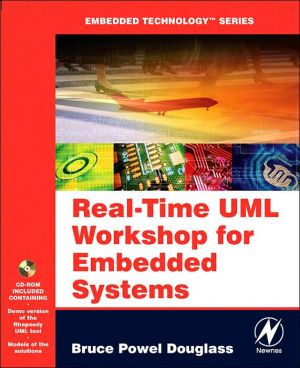

 |

|

Sold Out
Book Categories |
Preface xiii
Audience xiv
Goals xv
Where to Go After the Book xv
Evaluate UML on ARM xv
Acknowledgments xvii
About the Author xix
What's on the CD-ROM? xxi
Introduction 1
Basic Modeling Concepts of the UML 1
Structural Elements and Diagrams 5
Small Things: Objects, Classes, and Interfaces 5
Relations 10
Big Things: Subsystems, Components, and Packages 17
Behavioral Elements and Diagrams 19
Actions and Activities 19
Operations and Methods 20
Activity Diagrams 20
Statecharts 22
Interactions 27
Use Case and Requirements Models 31
Summary 33
Check Out the CD-ROM 33
The Harmony Process 35
Introduction 35
The Harmony Development Process 36
Why Process? 36
Harmony Process Overview 41
The Systems Engineering Harmony Workflows in Detail 43
The Incremental (Spiral) Development Workflowsin Detail 47
Increment Review (Party!) Workflow 48
Design with the Harmony Process 55
Implementation 60
Test 61
Summary 63
Specifying Requirements 65
Overview 65
Identifying Kinds of Requirements for Roadrunner Traffic Light Control System 67
Identifying Use Cases for the Roadrunner Traffic Light Control System 69
Mapping Requirements to Use Cases 69
Identifying Use Cases for the Coyote UAV System 70
Identifying Parametric Requirements 70
Capturing Quality of Service Requirements in Use Cases 71
Operational View: Identifying Traffic Light Scenarios 71
Operational View: CUAVS Optical Surveillance Scenarios 73
Specification View: Use-Case Description 73
Specification View: State Machines for Requirements Capture 74
Specification View: Capturing Complex Requirements 76
Operational to Specification View: Capturing Operational Contracts 77
References 82
Systems Architecture 83
Overview 83
Organizing the Systems Model 85
Subsystem Identification 90
Mapping Operational Contracts into Subsystem Architecture 92
Identifying Subsystem Use Cases 101
Looking Ahead 107
Object Analysis 109
Overview 109
Key Strategies for Object Identification 111
Underline the Noun Strategy 113
Identify the Causal Agents 113
Identify Services (Passive Contributors or Server Objects) 114
Identify Messages and Information Flows 114
Identify Real-World Items 114
Identify Physical Devices 114
Identify Key Concepts 115
Identify Transactions 115
Identify Persistent Information 115
Identify Visual Elements 115
Identify Control Elements 116
Apply Scenarios 116
Apply Nouns and Causal Agents Strategies 116
Apply Services and Messages Strategies 125
Apply Real-World Items and Physical Devices Strategies 127
Apply Key Concepts and Transaction Strategies 128
Apply Identify Visual Elements and Scenarios Strategies 128
Merge Models from the Various Strategies 137
Looking Ahead 139
Architectural Design 141
Overview 141
Concurrency and Resource Architecture 147
Distribution Architecture 158
Safety and Reliability Architecture 163
Looking Ahead 177
Mechanistic and Detailed Design 179
Overview 179
Mechanistic Design 180
Delegation Pattern Strategy 183
Interface Abstraction Pattern Strategy 185
Detailed Design 187
Applying Mechanistic Design Patterns-Part 1 192
Applying Mechanistic Design Patterns-Part 2 196
Applying Detailed-Design State Behavior Patterns 201
Applying-Detailed Design Idioms 206
Summary 214
Specifying Requirements: Answers 215
Identifying Kinds of Requirements 215
Identifying Use Cases for Roadrunner Traffic Light Control System 216
Mapping Requirements to Use Cases 219
Identifying Use Cases for Coyote UAV System 220
Identifying Parametric Requirements 222
Capturing Quality of Service Requirements 223
Operational View: Identifying Traffic Light Scenarios 224
Operational View: CUAVS Optical Surveillance Scenarios 228
Specification View: Use-Case Descriptions 231
Specification View: Capturing Complex Requirements 232
Operational to Specification View: Capturing Operational Contracts 238
References 242
Systems Architecture: Answers 243
Organizing the Systems Model 243
Subsystem Identification 250
Mapping Operational Contracts into the Subsystem Architecture 256
Identifying Subsystem Use Cases 267
Object Analysis: Answers 273
Apply Nouns and Causal Agents Strategies 273
Apply Services and Messages Strategies 291
Applying the Real-World Items and Physical Devices Strategies 297
Apply Key Concepts and Transaction Strategies 299
Identify Visual Elements and Scenarios Strategies 303
Merge Models from the Various Strategies 315
Architectural Design: Answers 317
Concurrency and Resource Architecture 317
Distribution Architecture 319
Safety and Reliability Architecture 323
Mechanistic and Detailed Design: Answers 339
Applying Mechanistic Design Patterns-Part 1 339
Applying Mechanistic Design Patterns-Part 2 341
Applying Detailed-Design State Behavior Patterns 346
Applying Detailed-Design Idioms 351
The Roadrunner Intersection Controller System Specification 357
Overview 357
The Intersection Controller (IC) 357
Configuration Parameters 358
Intersection Modes 361
The Vehicle Detector 365
Vehicular Traffic Light 366
Pedestrian Light and Sensor 367
Front Panel Display 368
Remote Communications 369
Power 370
The Coyote Unmanned Air Vehicle System (CUAVS) Specification 371
Overview 371
Primary CUAV System Components 371
The Unmanned Air Vehicle (UAV) 371
The Coyote Mission Planning and Control System (CMPCS) 372
Coyote Payloads 372
The Coyote Datalink Subsystem (CDS) 373
Detailed Requirements 373
The Unmanned Air Vehicle (UAV) 373
Flight Modes 373
Mission Modes 374
The Coyote Mission Planning and Control System (CMPCS) 374
The Coyote Reconnaissance Sensor Suite Payload (CSSP) 375
The Coyote Hellfire Attack Payload (CHAP) 376
The Coyote Datalink Subsystem (CDS) 377
UML Notational Summary 379
Index 401
Login|Complaints|Blog|Games|Digital Media|Souls|Obituary|Contact Us|FAQ
CAN'T FIND WHAT YOU'RE LOOKING FOR? CLICK HERE!!! X
 You must be logged in to add to WishlistX
 This item is in your Wish ListX
 This item is in your CollectionReal Time UML Workshop for Embedded Systems
X
 This Item is in Your InventoryReal Time UML Workshop for Embedded Systems
X
 You must be logged in to review the productsX
 X
 X

Add Real Time UML Workshop for Embedded Systems, This practical new book provides much-needed, practical, hands-on experience capturing analysis and design in UML. It holds the hands of engineers making the difficult leap from developing in C to the higher-level and more robust Unified Modeling Language, Real Time UML Workshop for Embedded Systems to the inventory that you are selling on WonderClubX
 X

Add Real Time UML Workshop for Embedded Systems, This practical new book provides much-needed, practical, hands-on experience capturing analysis and design in UML. It holds the hands of engineers making the difficult leap from developing in C to the higher-level and more robust Unified Modeling Language, Real Time UML Workshop for Embedded Systems to your collection on WonderClub |